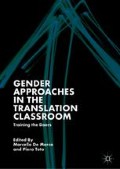Abstract
TranslatorTraining has, for a number of years, been a key topic of research in Translation Studies—its methods, techniques and paradigms having been the subject of discussion for decades. In this volume, such practices are explored from a variety of perspectives and by contributors whose academic, professional and personal experience informs their pedagogy.
Access this chapter
Tax calculation will be finalised at checkout
Purchases are for personal use only
References
Corrius, M., M. De Marco, and E. Espasa. 2016. Situated Learning and Situated Knowledge: Gender and Translating Audiovisual Adverts. The Interpreter and Translator Trainer 10 (1): 59–75.
De Marco, M. 2011. Bringing Gender into the Subtitling Classroom. In Audiovisual Translation: Subtitles and Subtitling—Theory and Foreign Language Practice, ed. L. Incalcaterra McLoughlin, M. Biscio, and M.Á. Ní Mhainnín, 139–155. New York, Bern, Berlin, Bruxelles, Frankfurt am Main, Oxford, and Wien: Peter Lang.
Doherty, S. 2016. The Impact of Translation Technologies on the Process and Product of Translation. International Journal of Communication 10 (2016): 947–969.
Farid, G. 2016. Integration or Discrimination of French Feminine Grades and Titles? In Language for International Communication: Linking Interdisciplinary Perspectives, ed. I. Karapetjana and D. Liepiņa, 41–48. Latvia: University of Latvia.
Gile, D. 2009. Basic Concepts and Models for Interpreter and Translator Training, Rev. ed. Amsterdam and Philadelphia: John Benjamins Publishing.
Holmes, J. 1972. Translated! Papers on Literary Translation and Translation Studies. Amsterdam: Rodopi.
International Labour Office. 1998. Gender Mainstreaming in Local Economic Development Strategies: A Guide. Geneva: ILO.
Kiraly, D. 2000. A Social Constructivist Approach to Translator Education. Empowerment from Theory to Practice. Manchester: St. Jerome.
Marshman, E., and L. Bowker. 2012. Translation Technologies as Seen Through the Eyes of Educators and Students: Harmonizing Views with the Help of a Centralized Teaching and Learning Resource. In Global Trends in Translator and Interpreter Training: Mediation and Culture, ed. S. Hubscher-Davidson and M. Borodo, 69–95. London and New York: Continuum.
Miller, C., and K. Swift. 1995. The Handbook of Non-sexist Writing for Writers, Editors and Speakers, 3rd ed. London: The Women’s Press.
Orlando, M. 2012. Training of Professional Translators in Australia: Process-Oriented and Product-Oriented Evaluation Approaches. In Global Trends in Translator and Interpreter Training: Mediation and Culture, ed. S. Hubscher-Davidson and M. Borodo, 197–216. London and New York: Continuum.
Pym, A. 2003. Redefining Translation Competence in an Electronic Age, in Defence of a Minimalist Approach. Meta: Translators’ Journal 48 (4): 481–497.
———. 2009. Translator Training. Pre-print Text Written for the Oxford Companion to Translation Studies. Available at http://www.tinet.org/~apym/on-line/training/2009_translator_training.pdf. Accessed 14 October 2017.
———. 2012. Translation Skill-Sets in a Machine-Translation Age. Available at http://usuaris.tinet.cat/apym/on-line/training/2012_competence_pym.pdf. Accessed 14 October 2017.
Sabatini, A. 1987. Raccomandazioni per un uso non sessista della lingua italiana. Per la scuola e per l’editoria scolastica. Rome: Presidenza del Consiglio dei Ministri.
Tymoczko, M., and E. Gentzler (eds.). 2002. Translation and Power. Amherst and Boston: University of Massachusetts Press.
World Economic Forum. 2015. Available at https://www.weforum.org/agenda/2015/05/why-education-is-the-key-to-sustainable-development/. Accessed 16 November 2018.
Author information
Authors and Affiliations
Corresponding author
Editor information
Editors and Affiliations
Rights and permissions
Copyright information
© 2019 The Author(s)
About this chapter
Cite this chapter
De Marco, M., Toto, P. (2019). Introduction: The Potential of Gender Training in the Translation Classroom. In: De Marco, M., Toto, P. (eds) Gender Approaches in the Translation Classroom. Palgrave Macmillan, Cham. https://doi.org/10.1007/978-3-030-04390-2_1
Download citation
DOI: https://doi.org/10.1007/978-3-030-04390-2_1
Published:
Publisher Name: Palgrave Macmillan, Cham
Print ISBN: 978-3-030-04389-6
Online ISBN: 978-3-030-04390-2
eBook Packages: Social SciencesSocial Sciences (R0)

